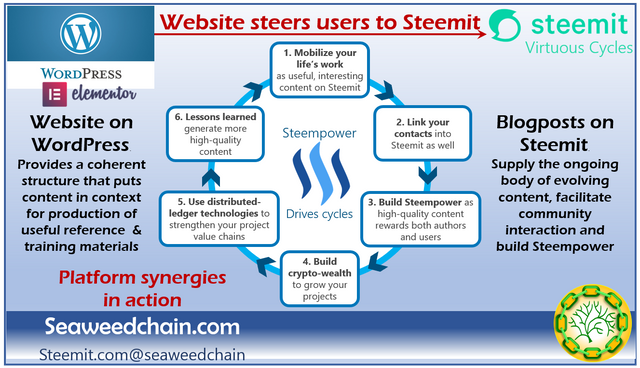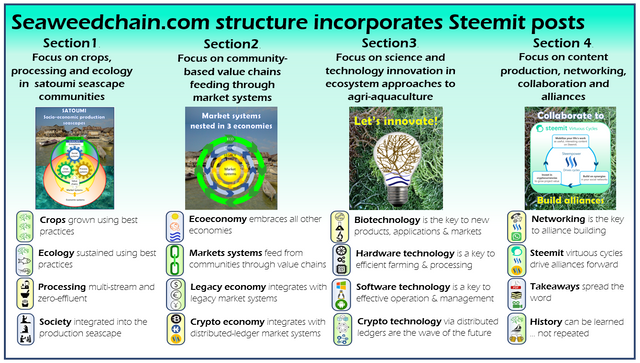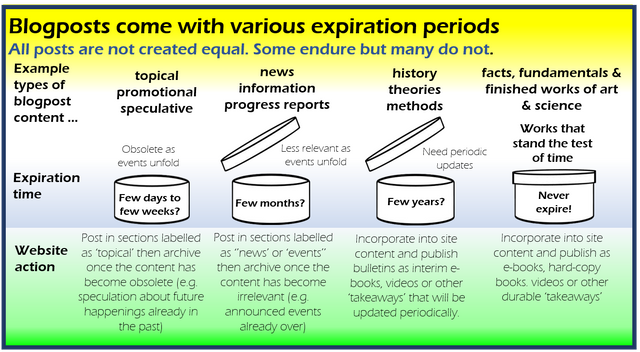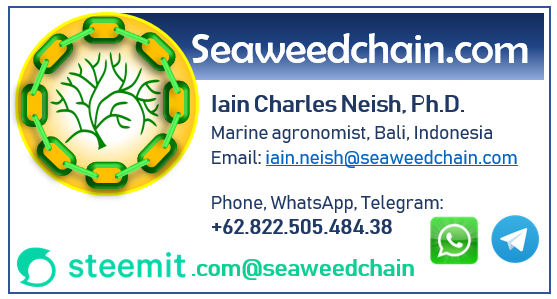Steer users to Steemit blogposts while using WordPress websites for context

Steemit is good for blogposts but we need to connect posts to a coherent structure for long-term content development. The solution that I am personally testing is to develop the WordPress website at SeaweedChain.com as an overarching structure and to do blogposts on Steemit.com@seaweedchain. Various means for connecting the two are in development so I am still groping for the optimum formula. Content from the two platforms is being combined to create e-books, course materials and other forms of reference material for use in real-world projects. I retain files with the images and text of each post that I do on Steemit, so I can readily reproduce them or do edited versions in various formats.
Linking of posts to the website is low-tech for now

I am experimenting with various widgets that link Steemit and WordPress (see some references below) but for now I am going ‘low-tech’ in linking my Steemit posts to the website. I simply list Steemit posts on the relevant website pages, so readers can go over to Steemit to see them. In the process, I hope they will decide to sign on to Steemit and help to build Steemit communities.
The structure of my website was previewed on my Steemit post entitled “Four foundation frameworks for seashore aquaculture development”. A revised version is depicted in the image above. Most of my Steemit blogposts fit into one or more of the website sections indicated on the sitemap so as posts are written they are incorporated and/or posted as website content.
All blogposts are not created equal

For present purposes I have placed types of blogpost in four categories as indicated in the image above. The categories are defined by the ‘shelf life’ or ‘expiration period’ of blogpost content as follows:
Topical, promotional and speculative posts relevant for days or weeks
Lots of posts have a shelf-life that can measured in days. These are posts such as predictions of where cryptocurrency prices will be by a certain time or promotion of an ICO that will happen soon. A prediction whose time has passed retains relevance especially if it is part of a pattern that becomes part of history … perhaps because it indicates an outstanding track-record of correct (or wrong) predictions.
News, information and progress reports relevant for weeks or months
Posts such as these are reporting on current events as they happen but before they can be placed in historical context. For example, they may cover cryptocurrency movements over time and up to the date of post publication; or they may report the results of an ICO rollout. In due course such posts get archived as their content is assimilated into history.
History, theories and methods relevant for months or years
Posts that report history; present well-developed and tested theories; or describe validated methods for doing things can be relevant for many months or years until they require an update. For example, ‘how-to’ posts about how to integrate Steemit content into WordPress websites should be updated once widgets and programming prove their efficacy in daily practice.
Facts, fundamentals and finished works that stand the test of time
Most of my blogposts fall either into this category or into the previous one. They strive to present fundamental models that have stood the test of time during application to practical aquaculture enterprise development along tropical seashores. Many of these principles were relevant 50+ years ago when I started in the game and will continue, I hope, to be relevant at least 50 years hence.
Takeaways that turn blogposts into enduring KITS
In and of themselves blogposts are a stream of blurbs that may be more (or less) profound, but they are not well suited to practical application in real-world projects or business development. Before action can be taken, blogpost material must be used to create knowledge, information, tools and solutions (KITS) designed for to reach specific goals. (see my recent post entitled “Six steps for harnessing Steemit virtuous cycles to grow your projects” for more about KITS).
For me the Seaweedchain.com WordPress website is central to the process of KITS production. It facilitates contacts that lead to collaborative projects and it also serves as the distribution hub for materials such as PDF e-books, hard-copy publications, videos and images. In the past I have successfully used websites for these purposes including the now-defunct SuriaLink.com, Satoumi.co and Seaplant.net and I am still affiliated with Jasuda.net but none of these websites has generated income in and of themselves. Also, they have had limited followings due to the limited ‘niches’ that they inhabited.
I am hoping that by harnessing the strengths of Steemit and the WordPress website I can build a more effective platform for moving things forward through the SeaweedChain project.
So full Steem ahead!
Cheers, Iain
References:
Some go-to sources for linking Steemit to WordPress are
https://steemit.com/@wordpress-tips
https://steemit.com/@howo
https://steemit.com/@mcfarhat

Congratulations @seaweedchain! You received a personal award!
Click here to view your Board
Do not miss the last post from @steemitboard:
Downvoting a post can decrease pending rewards and make it less visible. Common reasons:
Submit
Congratulations @seaweedchain! You received a personal award!
You can view your badges on your Steem Board and compare to others on the Steem Ranking
Do not miss the last post from @steemitboard:
Vote for @Steemitboard as a witness to get one more award and increased upvotes!
Downvoting a post can decrease pending rewards and make it less visible. Common reasons:
Submit